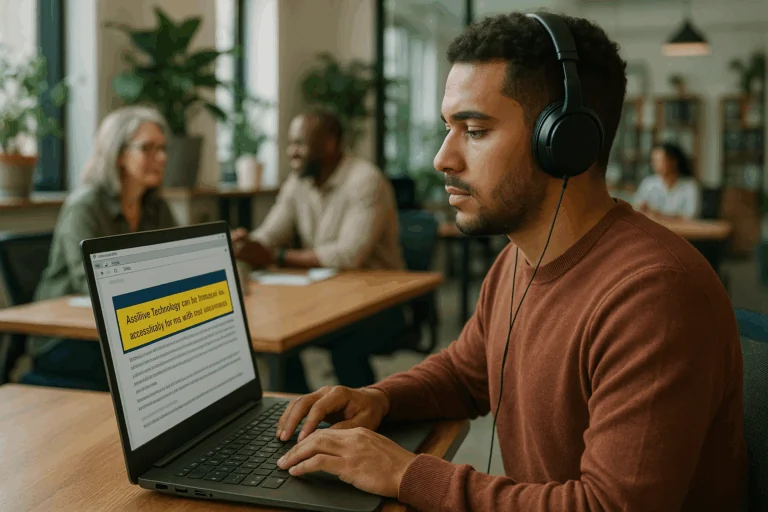🤔 Or how someone with a motor disability interacts with your online forms? With the web becoming an increasingly integral part of our daily lives, the importance of building inclusive and accessible websites cannot be overstated. But how exactly can we achieve this? The answer lies in the power of HTML accessibility.
In this article, we will delve deep into the world of HTML accessibility – an area of web development that is often misunderstood and overlooked, yet incredibly crucial. By understanding and applying the principles of HTML accessibility, we can ensure our websites are usable by all, regardless of their physical or cognitive abilities. 🌐
Before we go any further, it’s important to clarify that HTML accessibility is not just about catering to users with disabilities. An accessible website benefits all users by providing a better, more efficient, and more satisfying browsing experience. This, in turn, can lead to increased user engagement, improved SEO rankings, and ultimately, greater success for your online business.💡
We will kick things off by discussing the concept of digital accessibility, its significance, and how it ties into the world of HTML. This will provide the necessary groundwork for understanding the more technical aspects of HTML accessibility.
From there, we will move onto exploring various HTML elements and attributes that are essential for creating an accessible website. These include but are not limited to alt attributes for images, label elements for form fields, and lang attributes for multilingual content. We will delve into each of these elements and discuss how to use them correctly to maximize their accessibility potential.🔍
Next, we will venture into the realm of ARIA (Accessible Rich Internet Applications) and discuss how it enhances HTML accessibility by providing additional ways to convey information to assistive technologies. This section will feature practical examples and tips on using ARIA roles, states, and properties to improve the accessibility of complex web components like sliders, menus, and dialog boxes.💪
After that, we will cover some common accessibility pitfalls and how to avoid them. We’ll talk about issues like color contrast, keyboard navigation, and form validation, providing practical advice on how to address them in your HTML code.
Finally, we will wrap things up by discussing some testing tools and methodologies for checking your website’s accessibility. This will equip you with the necessary resources to validate your efforts and ensure that your website truly is inclusive for all users.🔧
Whether you are a seasoned web developer or just dipping your toes into the world of HTML, this article will serve as a comprehensive guide to making your website more accessible. So let’s embark on this journey towards a more inclusive web. 💼
🔓Unlocking HTML Accessibility: A Comprehensive Overview
As digital technology continues to evolve, website accessibility has become a topic of paramount importance. With an increasing number of activities transitioning online, it’s crucial to ensure that websites are inclusive and accessible to all users. In this context, HTML (HyperText Markup Language) plays a critical role. In this article, we will explore how HTML can be harnessed to make websites more accessible.
Before we delve deeper, let’s clarify what we mean by ‘website accessibility.’ This refers to the practice of designing and developing websites, applications, and technologies in such a way that people with disabilities can use them. Ideally, your website should be easily navigable, understandable, and interactive for all users, irrespective of any physical or cognitive disabilities they may have.
But how does HTML factor into this? HTML is a markup language used for structuring and presenting content on the web. It includes various elements like headers, paragraphs, links, and images. By using HTML correctly, you can significantly improve your website’s accessibility. This article will explain how, so keep reading!
🔑The Power of HTML in Promoting Accessibility
HTML’s power in promoting accessibility comes from its structured nature. The HTML code defines the structure of a webpage – it tells the browser what each part of the page is, whether it’s a header, a paragraph, a link, or an image. This information can be used by assistive technologies to interpret the page and present it to users in a way they can understand and interact with.
For instance, screen readers – tools used by visually impaired users to ‘read’ the content on the screen – rely heavily on HTML structure. They use the HTML elements to understand the webpage’s structure and then convey this information to the user in a comprehensible manner. By using semantic HTML elements, you can greatly enhance the user experience for these individuals.
To illustrate this point, let’s consider an example. Below is a video from the YouTube channel ‘Google Chrome Developers’ titled ‘Accessibility: Improving the UX for all users’. This video provides a succinct yet comprehensive overview of how HTML can be used to improve accessibility.
🛠️Implementing HTML Accessibility: Essential Techniques and Practices
There are numerous techniques and practices you can implement to make your website more accessible using HTML. The key is to use HTML elements correctly and to their full potential. Let’s look at some essential techniques.
✔️Use Semantic HTML Elements
Semantic HTML elements are those that describe their meaning to both the browser and the developer. Examples include <header>, <footer>, <nav> (navigation), <main> (main content), and <article>. Using these elements can greatly improve accessibility as they provide additional context for assistive technologies.
✔️Provide Alternative Text for Images
Images can be a significant barrier for visually impaired users if they don’t include alternative text. The alternative text (alt text) is a brief description of the image, which can be read by screen readers. To include alt text, use the ‘alt’ attribute in the <img> element. For example: <img src=”image.jpg” alt=”Description of the image”>.
✔️Ensure Proper Use of Headers
Headers (h1, h2, h3, etc.) are essential for structuring your content and improving navigation. However, they should be used correctly. The <h1> should be used for the main title of the page, <h2> for major section headings, <h3> for subsections, and so on. This hierarchical structure can help assistive technologies understand the content’s structure.
🔎Comparing Accessible and Non-Accessible Websites: A Practical Example
To better understand the impact of HTML accessibility, let’s compare two hypothetical websites: one that implements HTML accessibility techniques and one that doesn’t.
| Feature | Accessible Website | Non-Accessible Website |
| Use of Headers | Headers are used hierarchically to structure content. | Headers are used inconsistently or not at all. |
| Alternative Text for Images | All images include descriptive alternative text. | Images do not include alternative text or the text is not descriptive. |
| Use of Semantic HTML Elements | Semantic HTML elements are used to provide additional context. | Non-semantic HTML elements are used, making the site difficult to navigate with assistive technologies. |
As you can see from the table above, the accessible website is more user-friendly, particularly for individuals using assistive technologies. By using HTML accessibility techniques, you can significantly enhance the user experience for all visitors, including those with disabilities.
🚀Taking HTML Accessibility to the Next Level: Advanced Techniques
While the techniques mentioned above are fundamental to HTML accessibility, there are also more advanced techniques that can be implemented to further improve accessibility. These techniques may require more knowledge and expertise in HTML and accessibility, but they can significantly enhance the user experience.
✔️Accessible Forms
Forms are a common feature on many websites, used for various purposes like user registration, login, and feedback. However, forms can be challenging for individuals with disabilities, particularly if they are not designed with accessibility in mind. Techniques like labeling form fields correctly, grouping related form controls, and providing clear error messages can greatly improve form accessibility.
✔️Accessible Tables
Tables are often used to present data in a structured manner. However, for individuals using screen readers, tables can be difficult to navigate if they are not designed correctly. Techniques like using the <th> element for table headers, providing captions, and using the <scope> attribute can make tables more accessible.
✔️Keyboard Navigation
Many individuals with disabilities rely on keyboards or keyboard-like devices to navigate websites. Ensuring your website is fully navigable using only the keyboard is a crucial aspect of accessibility. Techniques include providing visible focus indicators, ensuring logical tab order, and providing skip links.
🎯Resources for Learning More About HTML Accessibility
If you’re interested in learning more about HTML accessibility and how to implement it on your website, there are numerous resources available. Here are some recommendations:
- The A11Y Project: This community-driven initiative offers a wide range of resources, including tutorials, tips, and checklists for web accessibility.
- WebAIM (Web Accessibility In Mind): WebAIM provides comprehensive information, training, resources, guidelines, and standards for web accessibility.
- W3C Web Accessibility Initiative: The World Wide Web Consortium (W3C) offers a variety of resources, including guidelines, techniques, and tools for web accessibility.
These resources can provide you with a wealth of information on HTML accessibility, helping you make your website more inclusive for all users. Remember, website accessibility is not just a ‘nice-to-have’ – it’s a necessity in today’s digital age. By implementing HTML accessibility techniques, you’re not only improving the user experience for individuals with disabilities, but you’re also improving the overall quality and usability of your website.

Conclusion
In conclusion, we have discussed some important and intricate aspects of Software Engineering and Information Technology throughout this article. We dove into the realm of these ever-evolving fields, and how they continue to shape our world today. Let’s recap the main points that we’ve talked about.
We began our discussion by exploring the significance of Software Engineering, underlining how it lies at the heart of the technological advancements we witness today. In a world that is becoming increasingly digital, Software Engineering has become an integral part of almost every industry. From developing web applications to designing user-friendly interfaces, software engineers are responsible for creating solutions that make our lives easier and more efficient.
Next, we dived into the world of Information Technology (IT). We talked about how IT isn’t just about fixing computers anymore, but rather, it’s about providing strategic business solutions through managing and implementing technology. IT is the driving force behind every modern business, helping them run smoothly and achieve their goals.
We also examined the intersection of these two fields, discussing how IT and Software Engineering work together to create a harmonious technological ecosystem. With IT providing the infrastructure and Software Engineering developing the applications, both fields are indispensable to each other and to the larger technological landscape.
It is important to note that while these fields are different in their specific roles, they share a common goal: to leverage technology to solve problems and make life easier. And that is the crux of this article, understanding that these fields are not mutually exclusive, but rather, they complement each other to create a cohesive technological ecosystem.
As we move forward, it’s evident that the importance of these fields will only increase. With technology permeating every aspect of our lives, it’s crucial to understand how it works and how we can use it to our advantage. Whether you’re a seasoned professional or a curious novice, continuing to learn about these fields can open up a world of opportunities.
So why not dive deeper into this fascinating world of Software Engineering and IT? I encourage you to read more articles, join online discussions, enroll in courses, and explore more on your own. The internet is filled with resources that can help you in this journey. For further reading, you may refer to this comprehensive guide by [Harvard University](https://www.harvard.edu/) or this insightful article by [Stanford University](https://www.stanford.edu/). Remember, the more you learn, the more you grow.
In the end, it’s all about embracing the digital revolution and understanding how we can harness its power to shape our future. Let’s continue this conversation, share this article with your friends and colleagues, and let us know your thoughts in the comment section below. 💡🚀🌐
In this fast-paced digital world, staying informed and proactive is key. So, keep learning, keep growing, and most importantly, keep exploring. The future is here, and it’s digital. Until next time, happy reading! 👋📚🌟
<!– wp:paragraph –>
<!– /wp:paragraph –>
<!– wp:more –>
<!– /wp:more –>
<!– wp:paragraph –>
<!– /wp:paragraph –>
<!– wp:comments –>
<!– /wp:comments –>



